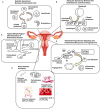Non-Invasive and Mechanism-Based Molecular Assessment of Endometrial Receptivity During the Window of Implantation: Current Concepts and Future Prospective Testing Directions
- PMID: 36303672
- PMCID: PMC9580756
- DOI: 10.3389/frph.2022.863173
Non-Invasive and Mechanism-Based Molecular Assessment of Endometrial Receptivity During the Window of Implantation: Current Concepts and Future Prospective Testing Directions
Abstract
Suboptimal endometrial receptivity and altered embryo-endometrial crosstalk account for approximately two-thirds of human implantation failures. Current tests of the window of implantation, such as endometrial thickness measurements and the endometrial receptivity assay, do not consistently improve clinical outcomes as measured by live birth rates. Understanding the mechanisms regulating the endometrial receptivity during the window of implantation is a critical step toward developing clinically meaningful tests. In this narrative review, the available literature is evaluated regarding mechanisms that regulate the endometrial receptivity during the window of implantation and the current tests developed. Overall, both animal and human studies point to five possible and interrelated mechanisms regulating the endometrial window of implantation: suitable synchrony between endometrial cells, adequate synchrony between the endometrium and the embryo, standard progesterone signaling and endometrial responses to progesterone, silent genetic variations, and typical morphological characteristics of the endometrial glands. The biological basis of current clinical markers or tests of window of implantation is poor. Future studies to elucidate the mechanisms shaping the window of implantation and to investigate the potential markers based on these mechanisms are required. In addition, molecular testing of the endometrium at single-cell resolution should be an initial step toward developing clinically meaningful tests for the optimal window of implantation. As understanding of the optimal window of implantation continues to evolve, one can envision the future development of non-invasive, mechanism-based testing of the window of implantation.
Keywords: endometrial receptivity; mechanism; molecular markers; non-invasive testing; point-of-care testing; window of implantation (WOI).
Copyright © 2022 Sun and Yeh.
Conflict of interest statement
The authors declare that the research was conducted in the absence of any commercial or financial relationships that could be construed as a potential conflict of interest.
Figures




Similar articles
-
Development of a new comprehensive and reliable endometrial receptivity map (ER Map/ER Grade) based on RT-qPCR gene expression analysis.Hum Reprod. 2018 Feb 1;33(2):220-228. doi: 10.1093/humrep/dex370. Hum Reprod. 2018. PMID: 29315421
-
Personalized Embryo Transfer Outcomes in Recurrent Implantation Failure Patients Following Endometrial Receptivity Array With Pre-Implantation Genetic Testing.Cureus. 2022 Jun 23;14(6):e26248. doi: 10.7759/cureus.26248. eCollection 2022 Jun. Cureus. 2022. PMID: 35911354 Free PMC article.
-
Correlation between plasmatic progesterone, endometrial receptivity genetic assay and implantation rates in frozen-thawed transferred euploid embryos. A multivariate analysis.Eur J Obstet Gynecol Reprod Biol. 2021 Aug;263:192-197. doi: 10.1016/j.ejogrb.2021.05.047. Epub 2021 Jun 9. Eur J Obstet Gynecol Reprod Biol. 2021. PMID: 34229182
-
Hormonal induction of endometrial receptivity.Fertil Steril. 2011 Sep;96(3):530-5. doi: 10.1016/j.fertnstert.2011.07.1097. Fertil Steril. 2011. PMID: 21880274 Review.
-
Clinical management of endometrial receptivity.Semin Reprod Med. 2014 Sep;32(5):410-3. doi: 10.1055/s-0034-1376360. Epub 2014 Jun 24. Semin Reprod Med. 2014. PMID: 24959823 Review.
Cited by
-
Elastography in Reproductive Medicine, a Game-Changer for Diagnosing Polycystic Ovary Syndrome, Predicting Intrauterine Insemination Success, and Enhancing In Vitro Fertilization Outcomes: A Systematic Review.Biomedicines. 2025 Mar 24;13(4):784. doi: 10.3390/biomedicines13040784. Biomedicines. 2025. PMID: 40299370 Free PMC article. Review.
-
Effects of Variable Embryo Transfer on the Variable Window of Implantation and Analysis of Pregnancy Outcomes.Cureus. 2024 May 10;16(5):e60020. doi: 10.7759/cureus.60020. eCollection 2024 May. Cureus. 2024. PMID: 38854330 Free PMC article.
-
The study on the clinical efficacy of endometrial receptivity analysis and influence factors of displaced window of implantation.Sci Rep. 2025 Mar 1;15(1):7326. doi: 10.1038/s41598-025-91745-y. Sci Rep. 2025. PMID: 40025209 Free PMC article.
-
The Impact of Endometriosis on Pregnancy.J Pers Med. 2024 Jan 22;14(1):126. doi: 10.3390/jpm14010126. J Pers Med. 2024. PMID: 38276248 Free PMC article. Review.
-
Endometrial E-cadherin and N-cadherin Expression during the Mid-Secretory Phase of Women with Ovarian Endometrioma or Uterine Fibroids.J Pers Med. 2024 Aug 29;14(9):920. doi: 10.3390/jpm14090920. J Pers Med. 2024. PMID: 39338174 Free PMC article.
References
Publication types
LinkOut - more resources
Full Text Sources
Research Materials

